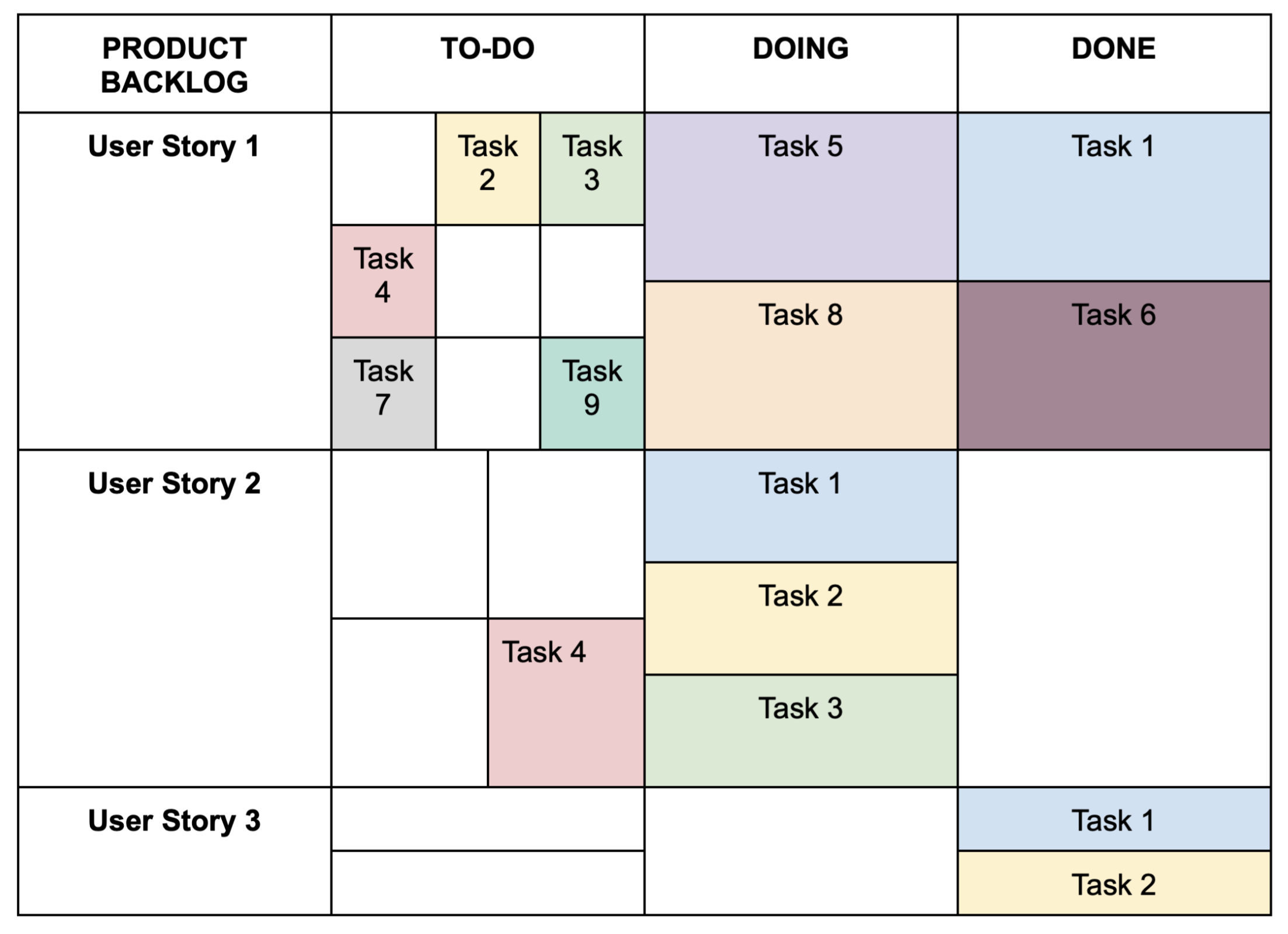No matter the approach, agile project management comes with a slew of tools to help get the job done. One of the best-known implements for teams operating within the Scrum framework is the Scrum board, a simple yet effective way to track work in progress.
The Scrum board may seem deceptively simplistic for newcomers to agile, but make no mistake. It’s the heart of Scrum project management, supporting the team’s activities throughout each sprint and springboarding them to success.
What is a scrum board?
Scrum boards are a visual task management tool for teams leveraging a Scrum-based project management model. They track the progress of sprint activities as they move through the team’s workflow to completion.
For those unfamiliar with Scrum, the project’s product owner divides work into sprints – time-boxed sessions typically lasting two to four weeks. During these intervals, the team uses a Scrum board as a visual to-do list.
During sprint planning, the Scrum team reviews user stories from the product backlog to determine which items the team will complete during the upcoming sprint. The Scrum Master transfers the information to a physical or virtual sticky note to add to the sprint backlog. Then, they assign the task to individual team members.
As the sprint progresses, the Scrum team updates the board so members can visualize who is doing what, which tasks are complete, and which still need work. This centralized hub for sprint activities provides the Scrum Master with a synchronized task view, allowing them to troubleshoot issues and clear backlogs.
The Scrum board can be physical – often a whiteboard hung in a visible location – or a digital application on everyone’s desktops. Regardless of the presentation, teams tailor Scrum boards to suit project requirements and hold members accountable.
Scrum board structure
To create the visual checklist, the Scrum board includes a column for every stage of the sprint’s workflow. At its most basic, the chart consists of three columns: To-Do, Doing, and Done.
You can expand these columns depending on your needs. For example, software development teams may add a fourth column labeled Testing before the Done category. Another option is a Product Backlog column, subdivided into User Story rows, to capture every project task – not just those in the current sprint.
Scrum board example

How to use a Scrum board
There’s no “right” way to populate a Scrum board – just whatever works for the team. Still, there are some standard steps. After dividing the board into phases to match the group’s workflow, the methodology generally follows these steps:
1. Define user stories
As part of sprint planning, review the product backlog to determine which user stories to add. Divide stories into action items and write each on a sticky note, including task description, priority, and assignment.
2. Add items to the To-Do column
Treat the To-Do column as the sprint backlog, capturing work the team intends to accomplish during the coming weeks. Add task sticky notes into the column and assign each one to a team member. Assignees are responsible for transferring notes to the next column at the end of each stage.
You can add project backlog items to the To-Do column, but only after the team has completed existing tasks.
3. Move activities to the Doing column
The Doing column tracks work-in-progress (WIP), providing a visual cue to the Scrum Master to help monitor execution. Some teams subdivide this column further for a more granular workflow visualization.
4. Finalize items by adding them to the Done column
Upon implementing the Scrum board, the project team must agree upon the “definition of done,” a series of criteria tasks must meet before transitioning into the Done column. For example, if a task fails the testing phase, it may return to the To-Do column, cycling between categories until it’s bug-free.
Benefits of the Scrum board
Scrum boards help project teams adhere to agile’s most essential principles, like sustainable delivery and simplicity. This provides the following benefits:
Clarity of focus
A Scrum board prioritizes tasks based on their contribution to sprint goals, keeping members focused on their work without becoming overwhelmed. Scrum Masters limit the number of tasks in each column, reducing multitasking and context switching to maintain high-quality performance.
Flexibility
Scrum boards allow for dynamic adjustments based on input from daily stand-ups or changing project priorities. Their visual nature encourages accountability and teamwork to overcome challenges and roadblocks.
Iterative improvement
Agile encourages regular retrospectives to assess the effectiveness of tools and processes, including the Scrum board. Teams use board data to identify and address potential improvements before beginning the next iteration.
Informed decisions
A digital Scrum board offers various reporting options, such as burndown charts, sprint velocity, and team capacity. This data allows stakeholders to make evidence-based decisions regarding resource allocation, project scope, and feature prioritization.
Manage risks
Teams that track tasks using a Scrum board are better equipped to respond to and mitigate risk. Team members can readjust priorities or plans when an issue arises.
Scrum board vs. Kanban board
Non-agile workers often confuse Scrum boards with Kanban boards – another agile project management tool. Both help teams track progress and assignments, map workflows, and visualize goals, but the similarities end there.
The primary differences between Scrum vs. Kanban boards are as follows:
| SCRUM | KANBAN | |
|---|---|---|
| Focus | Tracks short bursts of activity, delivering defined work increments at the end of every sprint. | Establishes a constant, deadline-free delivery workflow based on flexibility and progress. Teams prioritize tasks according to story point value and availability. |
| Structure | Teams organize Scrum boards into columns representing workflow stages, such as To-Do, In Progress, and Complete. | The Kanban board uses swimlanes representing various categories, such as departments, user stories, or features. Swimlanes limit WIP to prevent overwork. |
| Planning and monitoring | Populated according to goals and estimates established during sprint planning. Teams assess progress during daily stand-ups and project retrospectives. | Team members can add tasks and prioritize them according to capacity. Flow analysis and adjustments drive continuous team improvement. |
| Flexibility | Changes to an established sprint plan are limited but possible. | Constant adaptation and re-prioritization based on market and user inputs are the norm. |
| Responsibility | Teams are a tight-knit unit with a shared sense of ownership and commitment to achieving sprint goals. | Focuses on individual accountability and improvement. Team members work independently. |
Some agile teams combine the two methodologies into a single project management tool. The Scrumban board offers the best of both methods.
Physical vs. online Scrum board
Scrum masters and product owners often waffle between a physical Scrum board and a digital application. Both formats confer benefits. Here are factors to consider:
Team structure
A whiteboard is an excellent option if the project team works together in a physical location. It provides a constant visual reminder that keeps team members focused. A remote team doesn’t have the luxury of a shared space, so an online tool helps keep everyone connected.
Accessibility
An online project management tool allows team members to access and update sprint information from anywhere, whether at home, in separate offices, or at a conference.
Real-time information
Updating information on a digital Scrum board is straightforward. It often includes a feature that notifies team members of changes via email or instant message. Teams using a physical board must frequently check for updates.
Reporting
Online Scrum boards often integrate with other project management tools, such as Jira, to automatically create reports or update other planning and tracking tools, such as Gantt charts or burndown charts.
Common ground
Gathering around a physical Scrum board bolsters social connections between team members that remote teams often lack.
The best tool for using a Scrum board
Tempo understands that a Scrum board is the heart of a team’s agile practice. That’s why Strategic Roadmaps includes Scrum templates to support collaborative sprint planning. Strategic Roadmaps integrates with Jira software, making it easy to draft an audience-ready roadmap that aligns everyone with sprint priorities.









